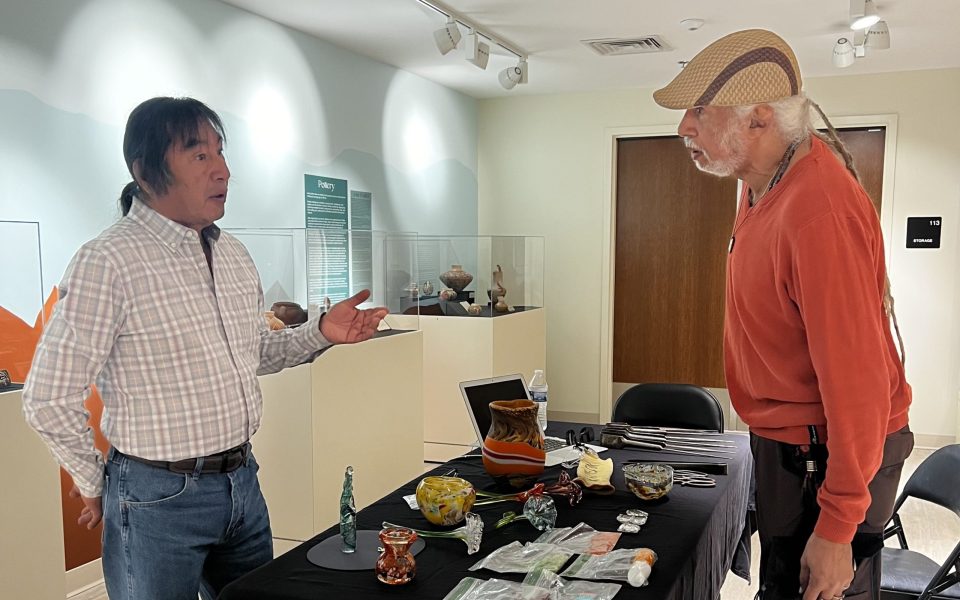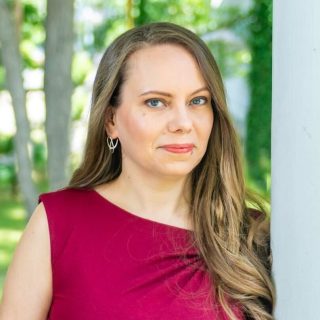Sitting at a long white table across from two women inside the Lam Museum of Anthropology on the campus of Wake Forest University on Saturday afternoon, Tamra Hunt reaches across lines of watercolor paints and containers of markers to gesture in wide circles at the blank paper between them. Born and raised in Greensboro, Hunt is a member of the Lumbee tribe and a longtime arts educator in the Triad.
“As an Indigenous artist, I feel connected with the Earth and with my God when I paint,” she says of her work. With its bright colors and organic shapes, her contemporary abstract art is both bold and accessible.
Tamra’s process is not one-sided. Rather, she connects with the physical manifestation of her artistic impetus on a deep level, resulting in an intuitive discourse between herself and the canvas.
“I allow the paint to communicate with me,” she says.

It’s this confidence in the surrender to the artistic process that she most notably brings to her students.
Hunt’s work, along with that of four other Indigenous artists, was on display alongside artist demonstrations this past weekend in Winston-Salem in celebration of Native American Heritage Month. While the museum has numerous pieces from Indigenous peoples within its permanent collection, through the latter part of January there’s a special exhibit titled Living Arts of the Hopi on display at the Lam.
Standing at a table nestled inside the Hopi exhibit is Ramson Lomatewama, a traditional katsina doll carver, poet, and the first Hopi glassblower. Talking to a museum guest, the former sociology professor is animated as he tells the story of his journey into this world of light and color.
After taking a tourist’s tour of the famous Corning Museum of Glass in New York, Lomatewama recalls saying to the security guard, “I think I found my calling.”
In the nearly two decades since, he’s built his own hot shop next to his house on the Hopi Reservation in Arizona. While he talks to visitors, Lomatewama shows them images of his makerspace, built singlehandedly with a combination of research and welding skills he learned in high school. His space is forged with repurposed materials, including an annealer frame he made from discarded university bed frames. He teaches glass art for the Hopitutuqayki (Hopi School), passing his passion onto a new generation.
Translucent shapes standing on his table echo the curves of earthenware jugs in the exhibit surrounding him. Glass-blowing is not a traditional Hopi artform, but Lomatewama has embraced it, melding this form of expression with his own cultural background to create something unique and valuable. Still, he continues to work to preserve his culture. He helped the museum staff at Lam by going through their materials, filling in catalog gaps, particularly in their Hopi collection.



Through the doorway Erika Reynolds, a Cherokee/Saura/Arawak artist based in Greensboro, sits with her teenage daughter at a long table piled with yarn, handmade soft goods and informational maps. She’s surrounded by several young people who lean intently over her, then mimic her finger movements on their own projects.
Erika learned finger weaving from her great grandmother, who first showed her how to do it when she was just four or five years old. Now, she teaches the practice in culture classes through Guilford County Schools and at exhibitions like this one.
“Things we do can either help or heal,” she says as her fingers deftly cross strands over one another.
She speaks warmly of the benefits of creative practices like weaving as a way to combat anxiety and stress.

“Nobody’s perfect except the creator,” she tells one of the visitors as they struggle to get a piece started. “If a mistake is there, it’s meant to be there.”
Tucked away in a room near the front of the museum, Taino Boriken artist Jeanette Egan expertly turns a gourd as she burns a detailed plant image into its pale bronze skin. Egan specializes in wood- and gourd-burning. Based in Coleridge, she was the chair of this year’s 80th annual NC Gourd Festival.
Though her background is in construction, Egan is now a full-time artist who teaches workshops around the area and sells her stunning creations at pow wows and festivals like the NC State Fair, where this year she was the first Hispanic artist to curate for the Village of Yesteryear. Her intersecting identities shine through in the bold floral designs on her work, invoking the tropical flowers of Puerto Rico, where she spent much of her formative years.
“The more I found out, the more the artwork called to me,” she shares of her journey as an artist.
The here artwork calls out to visitors through the bustling museum during the Indigenous Artists Showcase, offering depth and connection in celebration of Native culture. Though this special event is only for an afternoon, Native American art continues to breathe life into and evolve through these artists all year long.
Living Arts of the Hopi is on display through Jan. 23 at the Lam Museum of Anthropology. Admission is free. Learn more about the Lam Museum at lammuseum.wfu.edu
Join the First Amendment Society, a membership that goes directly to funding TCB‘s newsroom.
We believe that reporting can save the world.
The TCB First Amendment Society recognizes the vital role of a free, unfettered press with a bundling of local experiences designed to build community, and unique engagements with our newsroom that will help you understand, and shape, local journalism’s critical role in uplifting the people in our cities.
All revenue goes directly into the newsroom as reporters’ salaries and freelance commissions.


Leave a Reply